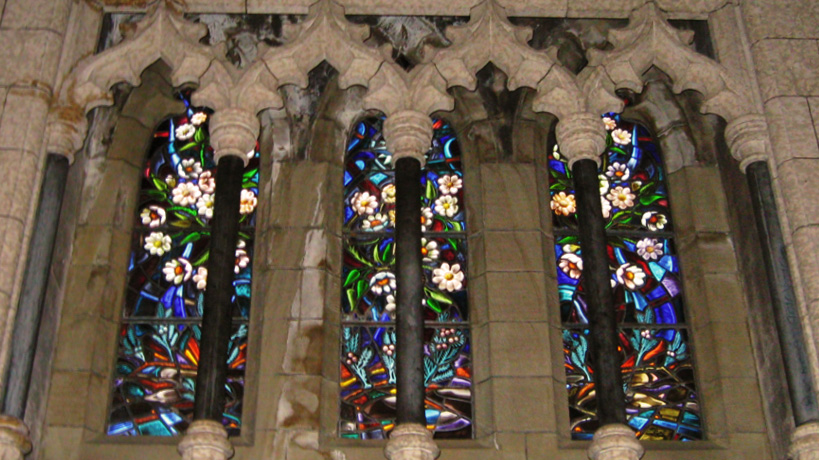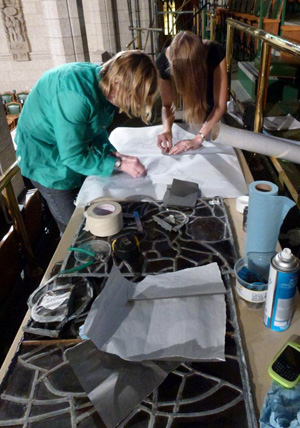House of Commons stained glass windows face mid-life crisis
April 2013
Think stained glass and images of medieval cathedrals might pop into your head. But some of the most magnificent stained glass windows in Canada occupy a more modern location—the House of Commons Chamber in Parliament Hill’s historic Centre Block.
Conceived as a project to commemorate Canada’s centennial, the installation of the stained glass windows had its roots in both democracy and practicality. The 12 windows, intricately decorated with the provincial and territorial floral emblems, symbolically represent the presence of each of these districts in the House of Commons. In practical terms, it solved a problem members of the Opposition had long complained about—that they were blinded by the light. The original bronze-tinted cathedral glass was not enough to block the setting sun from their eyes and there had long been talk of replacing the glass.
 The House of Commons stained glass window that represents the Northwest Territories has deteriorated and is in need of restoration.
The House of Commons stained glass window that represents the Northwest Territories has deteriorated and is in need of restoration.The windows were designed and created by former Dominion Sculptor Eleanor Milne, working with expert colourist Russell Goodman. Following her 30-foot drawings, the glass was cut and laid out like a jigsaw puzzle on Goodman’s dining room table. He intricately assembled approximately 2,000 pieces of glass per window to create Milne’s vision of flowers, ferns and bold aspects of the provincial and territorial shields.
When determining the position of each window in the Chamber, Milne followed the sun. “She ranged the windows of the eastern provinces of Newfoundland, Prince Edward Island, Nova Scotia, New Brunswick and Quebec along the east side of the Chamber, where the cool light evoked the grey and misty atmosphere of the Atlantic,
” reports architectural historian Jacqueline Hucker. “To enhance this effect, all the windows on this side of the Chamber are designed in cool colours. By contrast, the windows representing Ontario, Manitoba, Saskatchewan and Alberta on the west side of the Chamber are designed in warm colours, suggestive of the warm, beige grasses that grow across the landscape. For the British Columbia window, she introduced a bright blue to evoke a sense of the Pacific Ocean.
”
Fittingly, the windows representing Yukon and the Northwest Territories were installed at the north end of the Chamber. In place of a species of fern that anchors the design of 11 of the windows, the arctic willow accents the Northwest Territories window.
Unfortunately, the elegance of the windows’ artistic design was not matched by good structural bones. As a result, the windows—installed between 1971 and 1974—are experiencing something of a mid-life crisis.
“Although the stained glass panels themselves are well constructed, there has been a history of problems associated with their structural support,
” explains Isabelle Deslandes, Director, Portfolio and Project Management, Public Works and Government Services Canada (PWGSC). “As a result, some of the windows are deformed and a number of support bars are no longer doing their job.
”
 Workers carry out a rubbing of the stained glass window that represents the Northwest Territories. Its lead lines are outlined to create a pattern that will be used to reassemble the glass pieces during its restoration.
Workers carry out a rubbing of the stained glass window that represents the Northwest Territories. Its lead lines are outlined to create a pattern that will be used to reassemble the glass pieces during its restoration.As the custodian of the Parliament Buildings, PWGSC, working with the House of Commons, is determining how best to ensure these stained glass windows witness many centennials to come.
“I think that anyone who visits the House of Commons Chamber will be in awe of the beauty of these windows and will feel pride in how their province or territory is represented,
” says Ms. Deslandes. “And so, as there is no other stained glass of this kind in Canada, PWGSC is keenly aware of the significance of this restoration project.
”
In July 2012, one panel of the Northwest Territories window was delicately removed as a trial run. Once laid out, rubbings were carried out to create a pattern that is used to reassemble the glass pieces during restoration. This involved placing parchment paper over each section of the panel and then tracing the lead lines using the bare hand or a small piece of lead rolled in graphite paper. Precise measurements were taken and cracks and defects were recorded. The pilot panel is being stored for future restoration, but its removal is helping to inform the future treatment of all 12 windows.
To begin, two windows in need of immediate attention—the Manitoba and Northwest Territories windows—will be removed during the House of Commons 2013 summer recess.
“Temporary glass windows, laminated with printed images of the original stained glass pattern, will be installed in their place. The contractor selected to carry out the work will repair the masonry and modify the exterior glazing on all the windows, as this glazing is causing issues due to heat buildup,
” says Ms. Deslandes. “It will take between two and three weeks to painstakingly remove each window.
”
PWGSC will continue to monitor these priceless gifts to the country to determine if additional windows need to be removed before the major rehabilitation of the Centre Block gets underway. The windows that are removed in advance of that will be safely stored away and then restored during the major rehabilitation of the building.
View images of the House of Commons stained glass windows.
- Date modified: